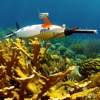Autonomous Systems Lab
The Autonomous Systems Laboratory (ASL) at the Virginia Institute of Marine Science (VIMS) creates innovative Autonomous Underwater Vehicles (AUVs) and develops new methods for them to explore the World Ocean.
Expeditions
 Scientific expeditions using our technology span the tropics to the poles. ASL robots have explored Antarctica, Bonaire, Chesapeake Bay, the Florida Keys, California, the Gulf of Mexico, and Iceland. Our robots map the seafloor; measure water quality; count and identify fishes, jellyfish, and krill; and explore shallow-water hydrothermal vents. ASL research contributes to national defense, including environmental security (detection of oil spills, toxins, and explosives), protection of ports and harbors, and countermeasures against rogue autonomous robots deployed by terrorists. Our work has been recognized by the Marine Technology Society's Lockheed Martin Award for Ocean Science & Technology, and the Commonwealth of Virginia's Outstanding Faculty Award.
Scientific expeditions using our technology span the tropics to the poles. ASL robots have explored Antarctica, Bonaire, Chesapeake Bay, the Florida Keys, California, the Gulf of Mexico, and Iceland. Our robots map the seafloor; measure water quality; count and identify fishes, jellyfish, and krill; and explore shallow-water hydrothermal vents. ASL research contributes to national defense, including environmental security (detection of oil spills, toxins, and explosives), protection of ports and harbors, and countermeasures against rogue autonomous robots deployed by terrorists. Our work has been recognized by the Marine Technology Society's Lockheed Martin Award for Ocean Science & Technology, and the Commonwealth of Virginia's Outstanding Faculty Award.
Education
Underwater robots are also used in STEM education from K-12 to unique undergraduate and graduate experiences like the Living Ocean Foundation's Project SeaCAMEL. We also work closely with industry partners through communities of interest like Robot Venture, research contracts, and the VIMS/Industry Partnership.
Technology Transfer
Our technology is available for license through William & Mary's Office of Technology Transfer. We also collaborate with researchers needing access to AUVs. In 2010, our AUV fleet is expanding to five. New research efforts are developing methods for mission planning and execution using robot swarms.

